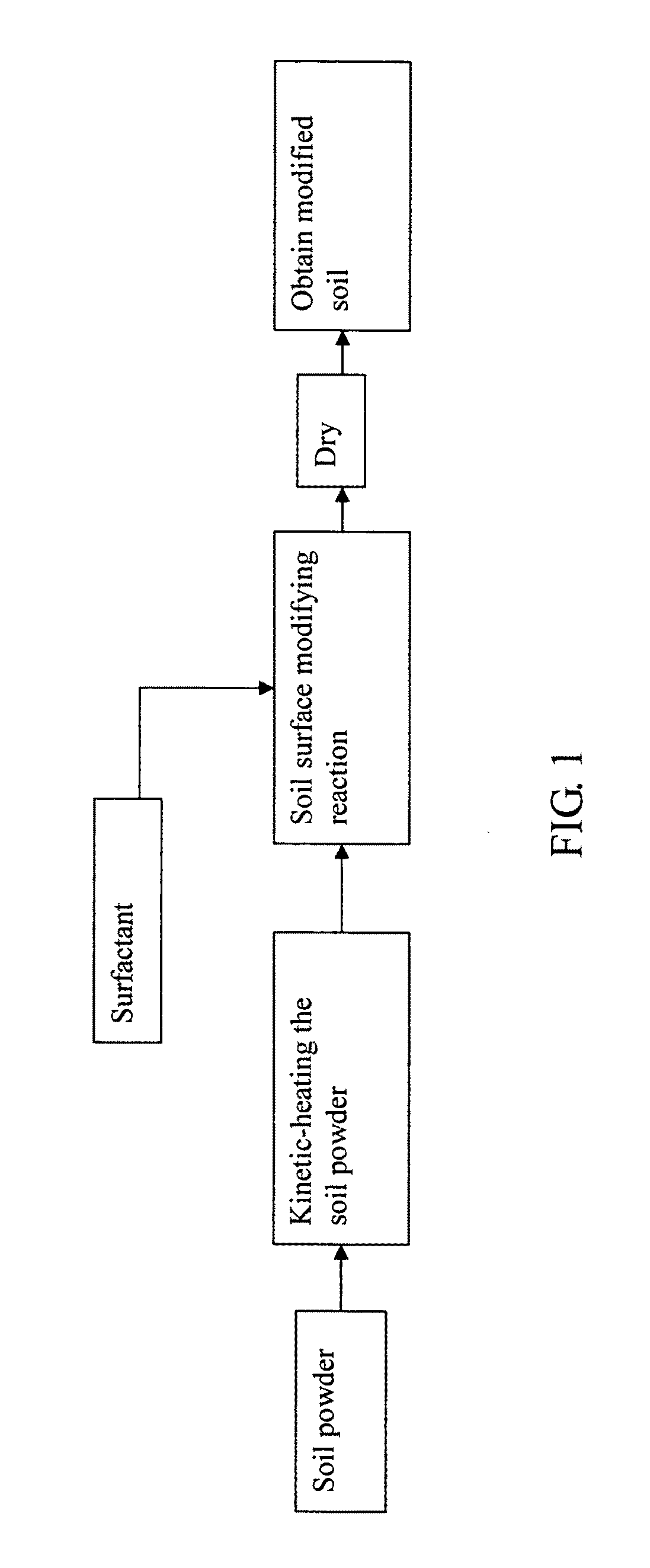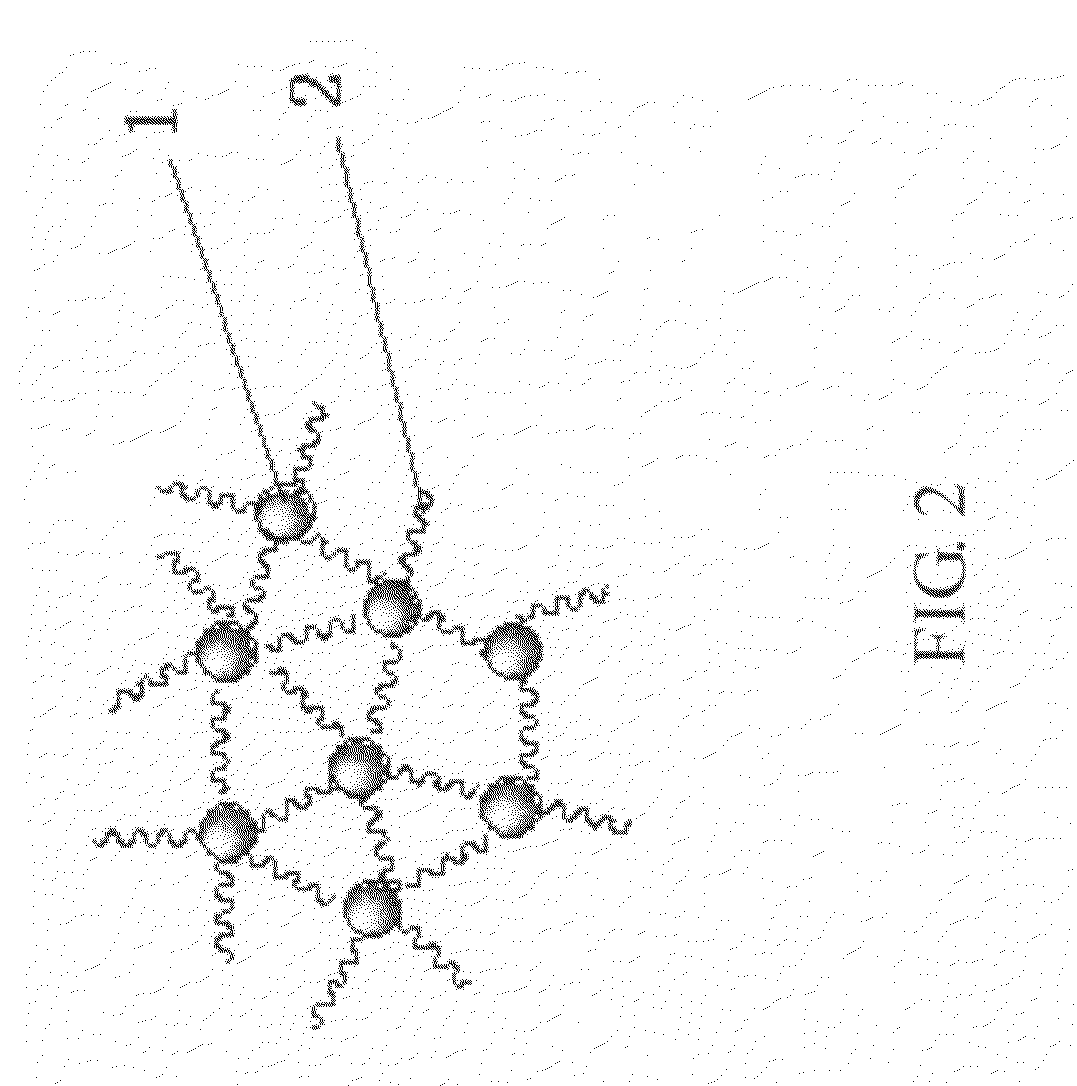Method for modifying Nomal Clay and a method for Producing Composite Elastomer from the Clay
a technology of clay and clay elastomer, which is applied in the field of polymer composites, can solve the problems of reducing the solvent-ability of epdm vulcanizate, no publications or references of modifying normal soil to be used in inorganic filling materials, and dramatic reduction of physical properties of thermoplastic products. , to achieve the effect of good ventilation, excellent elasticity, and flame retardan
- Summary
- Abstract
- Description
- Claims
- Application Information
AI Technical Summary
Benefits of technology
Problems solved by technology
Method used
Image
Examples
example 1
[0094]Obtain a predetermined amount of soil powder by collecting a predetermined amount of clean soil, preferably red clay; and drying, pulverizing, and sieving the red clay via 100 to 800 meshes to remove the rocky, gravels, and debris to obtain the soil powder. Alternatively, the soil powder can be obtained by mixing a predetermined amount of water with the soil; then sieving the mixed soil by 100 to 800 meshes to obtain a mud; and then drying and pulverizing the mud to obtain the soil powder. The surfactant used in this example is a silane coupling agent, which comprises vinyl trichlorosilane, polysiloxane having reactive functional group of a hydroxyl alkyl polysiloxane containing —(CH2)nOH, fatty acid alkyl silane, and water. The weight ratio of vinyl trichlorosilane, polysiloxane, fatty acid alkyl silane, and water is 1:3:1:96, wherein the surfactant is obtained by mixing the above mixtures. The modified soil powder is manufactured by the following steps: kinetic heating the s...
example 2
[0095]Obtain a predetermined amount of soil powder by collecting a predetermined amount of clean soil, preferably yellow clay; and drying, pulverizing, and sieving the yellow clay via 100 to 800 meshes to remove the rocky, gravels, and debris to obtain the soil powder. Alternatively, the soil powder can be obtained by mixing a predetermined amount of water with the soil; then sieving the mixed soil by 100 to 800 meshes to obtain a mud; and then drying and pulverizing the mud to obtain the soil powder. The surfactant used in this example is a silane coupling agent, which comprises β-(3,4-epoxy cyclohexyl)ethyl-trimethoxysilane, polysiloxane having reactive functional group of a hydroxyl alkyl polysiloxane containing —(CH2)3OCH(OH)CH2OH, fatty acid alkyl silane, and water. The weight ratio of β-(3,4-epoxy cyclohexyl)ethyl-trimethoxysilane, ethyl-trimethoxysilane, polysiloxane, fatty acid alkyl silane, and water is 2:5:0.5:92.5, wherein the surfactant is obtained by mixing the above mi...
example 3
[0096]Obtain a predetermined amount of soil powder by collecting a predetermined amount of clean soil, preferably white clay to mix with a predetermined amount of water; sieving the mixed soil by 100 to 800 meshes to obtain a mud, and drying and pulverizing the mud to obtain the soil powder. Alternatively, the soil powder can be obtained by mixing a predetermined amount of water with the soil; then sieving the mixed soil by 100 to 800 meshes to obtain a mud; and then drying and pulverizing the mud to obtain the soil powder. The surfactant used in this example is a silane coupling agent, which comprises 3-(methacryloyl-oxy)propyl-trimethoxysilane, polysiloxane having reactive functional group of a Carboxyl group polysiloxane, fatty amido alkyl trialkoxysilane, and water. The weight ratio of 3-(methacryloyl-oxy)propyl-trimethoxysilane, polysiloxane, fatty amido alkyl trialkoxysilane, and water is 0.8:6:0.7:92.5, wherein the surfactant is obtained by mixing the above mixtures. The modi...
PUM
| Property | Measurement | Unit |
|---|---|---|
| constant temperature | aaaaa | aaaaa |
| thickness | aaaaa | aaaaa |
| elongation | aaaaa | aaaaa |
Abstract
Description
Claims
Application Information
 Login to View More
Login to View More - R&D
- Intellectual Property
- Life Sciences
- Materials
- Tech Scout
- Unparalleled Data Quality
- Higher Quality Content
- 60% Fewer Hallucinations
Browse by: Latest US Patents, China's latest patents, Technical Efficacy Thesaurus, Application Domain, Technology Topic, Popular Technical Reports.
© 2025 PatSnap. All rights reserved.Legal|Privacy policy|Modern Slavery Act Transparency Statement|Sitemap|About US| Contact US: help@patsnap.com



